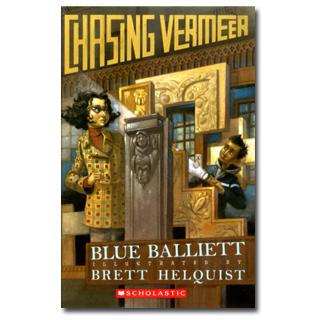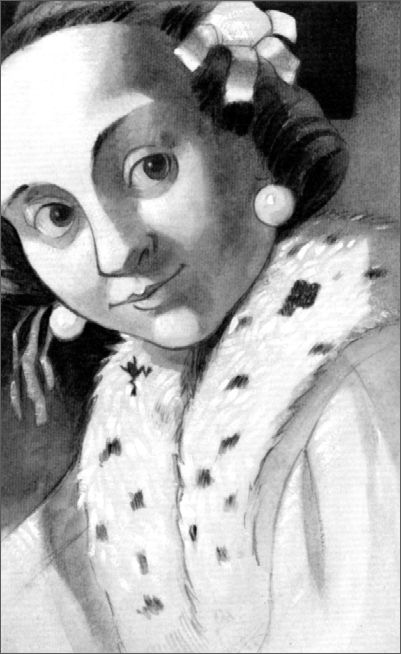
A FEW OTHER EVENTS FOR
MARCH 29:
- Happy birthday Suçie Stevenson (Henry and Mudge series).
- In 1882 the Knights of Columbus is established. Hence, it is Knights of Columbus Founders Day. Named in honor of Christopher Columbus, it is the largest Catholic fraternal service group in the world. Read Where Do You Think You’re Going, Christopher Columbus? by Jean Fritz, illustrated by Margot Tomes.
- It’s Smoke and Mirrors Day, to celebrate illusions. Read Smoke and Mirrors by Neil Gaiman, The Houdini Box by Brian Selznick, and Now You See It, Now You Don’t by Seymour Simon.
March has been designated Youth Art Month, set aside to promote art and art education in the United States. The perfect book to celebrate the month, Blue Balliett’s Chasing Vermeer, published in 2005, contains all the necessary elements to get young people thinking about art and artists.
Set at the University School in Hyde Park, Illinois, Chasing Vermeer features two very engaging protagonists, eleven-year-olds Petra and Calder. They have a lot in common: Both come from mixed racial backgrounds; both might be characterized as quirky loners. Calder plays with Pentominoes, a mathematical tool, and explores the world in terms of geometry and numbers. Petra has fallen under the spell of Charles Fort and his book Lo! which claims the world is full of strange events that no one witnesses. When Petra and Calder become friends, they bring two divergent and original minds together for a sleuthing team.
From the beginning of the book, readers know that some game is afoot. Three strange letters are delivered to surprised readers: “If you show this to the authorities, you will most certainly be placing your life in danger.” Petra and Calder’s teacher Ms. Hussey, a free thinker who they adore, begins to act suspiciously. Then the unthinkable happens—a valuable Vermeer painting, “A Lady Writing,” vanishes on route from Washington, D.C. to Chicago, where it’s been sent for an exhibition. The thief appears to be a total lunatic—for he/she is asking that people examine the career of Vermeer, get to know this genius’s paintings, post notes about him on the Internet, and determine which of the works attributed to him in museums are false. If all these things don’t happen, the thief will destroy this masterpiece.
Because of the premise, the book presents a lot of information about Vermeer that fits quite naturally into the story. While the world studies Vermeer, Petra and Calder begin to solve the crime. Although the police and everyone else remain clueless, these two sleuths build a pattern of clues and coincidences that lead them on a dark night, alone, into a deserted building to search for the painting’s hiding place.
Even Brett Helquist’s brooding artwork contains clues to the mystery; there are Pentominoes built into the composition. Just as quirky and original as the protagonists, Chasing Vermeer provides delightful, page-turning pleasure, and Petra and Calder reappear in two engaging sequels, The Wright 3 and The Calder Game, exploring Frank Lloyd Wright and Alexander Calder. All three focus on art and the creative process. For anyone trying to get a young person interested in painting, Chasing Vermeer makes a good place to begin. If you are using the book, you might want to watch John Schumaker’s video tour of the actual sites mentioned.
Here’s a passage from Chasing Vermeer:
Hours later, under a sliver of moon, Petra was almost asleep. As she rolled over, squashing her pillow into position on top of her arm, a strange thing happened: Although her eyes were closed, she seemed to be looking at a young woman.
This person was old-fashioned. She was dressed in a yellow jacket that had dappled fur on the edges, and her hair was pulled back tightly with shiny ribbons. Dangly earrings, perhaps pearls, caught the light. She had been sitting at a table and writing; something had interrupted her. Quill pen in hand, she had paused to look up.
The woman was gazing directly into Petra’s eyes. Her expression was knowing, filled with kindness and interest, and she had the look of someone who understood without being told.
Petra found herself soaking up every detail of the image. Although the room was dark, light touched the metal fastenings on a wooden box, a fold of blue cloth on the table, the curve of the woman’s forehead, the creamy lemon of her jacket. This was a calm, deliberate world, a world where dreams were real and each syllable held the light like a pearl. It was a writer’s world–and Petra was inside it.
Originally posted March 29, 2011. Updated for 2024.














I’ve read that some artists begin each day by absorbing something creative, as part of the “creative habit”
A little music, or looking at a few pieces of art. This website is part of my ritual.
I have seen this book but not read it. After reading your review Anita, I can’t wait to read Chasing Vermeer.
Gordon: Thank you so much for this note. I’m grateful to be part of your ritual. Anita
Hi Anita!
I just started reading Chasing Calder to my class. They are loving it!
My coffee hasn’t kicked in yet! I’m reading The Calder Game to my class!
This is one of my favorite children’s books! The mystery is well-crafted, and it raised my dormant interest in fine art. I love the message of how art is accessible to everyone. After reading this book with my younger siblings, we visited our local art museum and spent hours “appreciating” art, even if it was just making up stories behind paintings and sculptures.
Wow, G.Perry has said it for us all: The Almanac is part of our daily ritual.
Just like other almanacs that record and predict astronomical events, tides, weather influencing human behavior, the CBADA is a new force that changes the life of children around the world.
(I’m off to Chase Vermeer)
Read Aloud Dad
Hi Anita,
I decided to have a look at your almanac today and found this wonderful surprise–a book I represent! This is a coincidence that Petra and Calder would enjoy! Thank you for featuring this title.
I saw Blue Balliett interviewed on Good Morning America when she was promoting Chasing Vermeer. That TV interview piqued my interest to purchase Chasing Vermeer. Since then, I’ve read Chasing Vermeer and The Wright 3 and have really enjoyed them. I haven’t read The Calder Game yet even though I purchased it when it came out. I’ve recommended Chasing Vermeer to many of my students who enjoy mysteries, and they always comment on the use of the puzzles and codes. All have enjoyed the story. I enjoy the way Ms. Balliett weaves the mystery/story, the camaraderie, and the way she makes you think about the story as well as actual people – Johannes Vermeer and Frank Lloyd Wright.
I have not yet read Chasing Vermeer, but it sounds wonderful! I am always intrigued by lines such as, “They bring two divergent and original minds together for a sleuthing team.” I do love a good mystery!
Hi Anita,
In 2004, I gave this book to a student as a farewell gift. He was moving to Europe. Inspired by the book and taking advantage of their new location, his family planned many of their vacations with the quest of seeing all 35 Vermeers (1 is still stolen). This week, almost 7 years later, I received a photo book from that family showing my former student and his younger brother next to each of the paintings. One of the best teacher gifts I’ve received.
Anthony: Thank you for sharing this story — a very inspiring one.
Chasing Vermeer is a great mystery book for both children and adults. It is a very well written book with clues that I may be able to figure out. Thank you for inspiring me to like to write.
Wow! The illustrations are similar to Chris Van Allsburg’s illustrations. They’re very three dimensional, but also similar to comic strips too. Thanks, Anita!